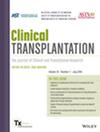T-cell Mediated Rejection Associated Microvascular Inflammation in the Allograft Kidney: RNAseq Analysis Using the Banff Human Organ Transplant Gene Panel
Abstract
Background
Microvascular inflammation (MVI) can occur in biopsies showing T-cell mediated rejection (TCMR), but it is not well established that T-cells can directly mediate microvascular injury (TCMR-MVI).
Methods
This was a cross sectional RNAseq based Banff Human Organ Transplant (BHOT) gene expression (GE) analysis. The objective of this study was to probe the molecular signature of TCMR-MVI in comparison with C4d+, DSA+ antibody mediated rejection (ABMR), stable renal function (STA), and TCMR without MVI. Transcriptome analysis utilized CLC genomic workbench and R-studio software.
Results
No gene set was specific for any diagnostic category, and all were expressed at low levels in STA biopsies. BHOT gene set scores could differentiate ABMR from TCMR and TCMR-MVI, but not TCMR from TCMR-MVI. TCMR-MVI underexpressed several genes associated with ABMR including DSATs, ENDAT, immunoglobulin genes, ADAMDEC1, PECAM1 and NK cell transcripts (MYBL1, GNLY), but overexpressed C3, NKBBIZ, and LTF. On the other hand, there was no significant difference in the expression of these genes in TCMR-MVI versus TCMR. This indicates that the GE profile of TCMR MVI aligns more closely with TCMR than ABMR. The limitations of classifying biopsies using the binary ABMR-TCMR algorithm, and the occurrence of common pathogenesis mechanisms amongst different rejection phenotype was highlighted by the frequent presence of molecular mixed rejection.
Conclusions
T-cell mediated mechanisms play a significant role in the pathogenesis of MVI. GE was broadly different between rejection phenotypes, but molecular scores varied substantially between biopsies with the same Banff grade. It was not always possible to achieve precise molecular score-based diagnostic categorization of individual patients.

 求助内容:
求助内容: 应助结果提醒方式:
应助结果提醒方式:


